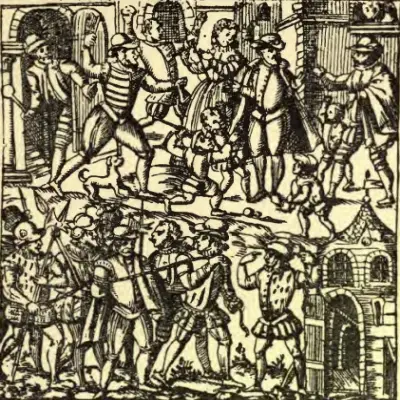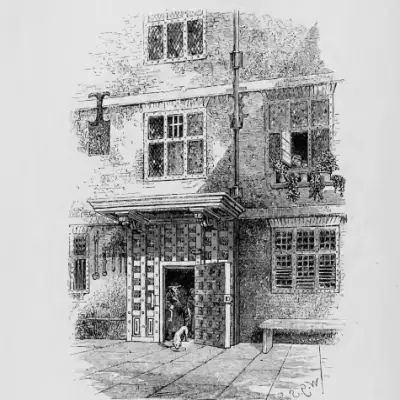The Incredible Story of Father John Gerard: Faith and Fortitude in Tudor England
Father John Gerard’s life is a testament to resilience, faith, and ingenuity. His story takes us deep into the dark world of Tudor prisons, where Catholics faced brutal persecution under Queen Elizabeth I. This blog explores his capture, imprisonment, and remarkable acts of defiance during one of history’s most turbulent times.
Capture and Early Days of Imprisonment
For the first two days after his arrest, Father John Gerard was held by magistrates. They questioned him about his ties to the Jesuits. Sir Thomas Egerton, once a Catholic but now loyal to the crown, led the interrogation. Despite pressure, Gerard refused to betray anyone. Impressed by his noble birth, Egerton ordered that he be treated well—even while sending him to the infamous Poultry Compter.

The Poultry Compter was no ordinary jail. It housed petty criminals—vagrants, drunks, debtors, prostitutes, and religious dissidents. Conditions were horrific. One account describes it as a place where “foul feet, dirty shirts, and stinking breaths poisoned the air worse than a tanner’s yard.” Yet, even here, Gerard stood firm.
Confrontation with Richard Topcliffe
In the Compter, Gerard faced Richard Topcliffe, a man known for cruelty. Topcliffe tried to trick Gerard into signing a confession. But Gerard outsmarted him. He wrote his own statement in a disguised hand and signed it so close to the bottom that nothing could be added later. When Topcliffe realized this, he was furious.
Gerard denied any involvement in politics, explaining: “As for matters of State, we are forbidden to have anything to do with them.” For three months, he endured iron shackles. By moving constantly, he polished the rust off them—a small act of defiance against his captors.
From Purgatory to Paradise: Life in the Clink
Thanks to influential friends, Gerard was transferred to the Clink at Southwark. Compared to the Poultry Compter, the Clink felt like paradise. Here, gaolers earned extra money through bribes. Gerard paid generously for privileges, turning his cell into a hub of Catholic activity.

He celebrated Mass, heard confessions, and converted prisoners. Other priests joined him, creating a thriving Catholic community within the prison walls. However, their activities did not go unnoticed. Richard Topcliffe returned, threatening execution on charges of treason. But fate intervened when Topcliffe himself landed in trouble after his son killed a man. Suspicion grew, leading to searches of Gerard’s cell—but all incriminating documents had already been hidden.
Torture in the Tower of London
On Lord Lieutenant Berkeley’s orders, Gerard was moved to the Salt Tower in the Tower of London. In his bare cell, he found comfort in carvings left by another martyred Jesuit, Henry Walpole. His charisma won over the gaoler, who upgraded him to a more comfortable cell.
But comfort didn’t last long. Gerard was summoned before the Lords Commissioner and the Queen’s Attorney. They demanded information about Father Garnet and accused him of treason. Calmly, he read the warrant for his torture and replied: “Do what God permits you, for you cannot go beyond.”

His torturers used a wooden pillar equipped with iron bands. They raised him by his wrists until his body weight made breathing nearly impossible. Though weakened, Gerard prayed aloud and refused to break. Even when fainting repeatedly, he never betrayed his fellow Catholics.
A Clever Ruse Amidst Suffering
After hours of torture, Gerard was returned to his cell. As he passed other prisoners, he shouted loudly, asking if he’d been questioned about Father Garnet. This clever move ensured that word reached Garnet, warning him without revealing his location. It also denied authorities the claim that Gerard had cracked under torture.
Despite swollen wrists and throat, Gerard continued resisting. Eventually, the lieutenant overseeing his torture resigned, unable to stomach the suffering inflicted on an innocent man.
Secret Communication Through Orange Juice Ink
During recovery, Gerard devised an ingenious method of communication. Friends smuggled large oranges to him. He shared the fruit with his gaoler, who loved oranges, and carved crosses from the peels to make rosaries. More importantly, he saved the juice to write invisible letters.
Orange juice reveals itself when heated by candlelight but doesn’t fade when cooled, proving unreadability beforehand. Using this technique, Gerard exchanged coded messages with friends outside. He wrote openly on one side of the paper and secretly on the other, exploiting his gaoler’s illiteracy.
One day, while dictating a letter, Gerard recited something different from what he wrote. This revealed the gaoler couldn’t read. From then on, Gerard became bolder, receiving updates about plans for his potential execution.
Planning an Escape
With rumors of his impending execution swirling, Gerard knew he had to act fast. His network of supporters worked tirelessly to orchestrate an escape plan. While details of this daring operation deserve their own chapter, suffice it to say that Gerard’s resourcefulness and courage played a key role.
Why Father John Gerard’s Story Matters Today
Father John Gerard’s tale isn’t just a historical account—it’s a lesson in perseverance, creativity, and unwavering faith. His ability to resist torture, maintain hope, and communicate covertly inspires us to stand strong in adversity. Whether you’re interested in history, religion, or human resilience, Gerard’s story offers timeless wisdom.
Final Thoughts
Father John Gerrard’s journey reminds us that even in the darkest places, light can shine through. His bravery in the face of unimaginable pain and his clever use of everyday items like orange juice show how determination and intellect can overcome oppression. Let his legacy inspire you to find strength in your struggles.
What aspect of Father John Gerard’s story resonates most with you? Share your thoughts below!

